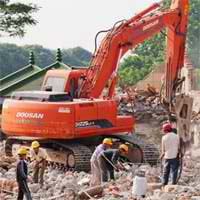Demolition May Raise Mesothelioma Risk

Do not take the dangers of asbestos for granted.
That warning comes directly from the Environmental Protection Agency (EPA) which admits to having done exactly that when it experimented with relaxing some of its own regulations for safe asbestos handling. EPA began regulating asbestos use after the material was linked to mesothelioma and a range of other health problems in the 1960’s. Airborne asbestos fibers can lodge in the lungs, triggering mesothelioma even decades after exposure.
Despite the danger, beginning in 1999, EPA considered alternative methods to “augment” the Asbestos National Emission Standards for Hazardous Air Pollutants, the act that governs asbestos handling during demolition. The alternative methods considered, including the Fort Worth Method and the Alternative Asbestos Control Method, leave some or all of the asbestos-containing material in place and allow demotion equipment to shred it. The material is wetted during demotion in an attempt to limit the release of fibers and lower the risk of mesothelioma.
But, in the recent statement, EPA Inspector General Arthur A. Elkins, Jr. said such methods still have the potential to stir up airborne asbestos and should, therefore, not have been considered. EPA’s Office of Research and Development ended the research project in July 2011 but apparently not all contractors have heard the message.
“Our preliminary research indicates that unapproved methods are currently being used or considered at multiple sites,” wrote Elkins in the statement. “The use of unapproved methods is counter to EPA regulations and… may jeopardize the health and safety of the public.” Among the sites where such unapproved methods may be used are the Hanford Superfund Site near Richland, Washington and a gaseous diffusion plant demolition in Paducah, Kentucky.
Video surveillance of these and other sites show government employees and contractors working without the required protective gear, raising their risk for mesothelioma and other asbestos related diseases. And because settled dust results indicated that asbestos fibers did escape the restricted areas, workers and members of the public who were adjacent to these sites during demotion could also be at higher risk for mesothelioma. The director’s statement calls on all sites using “unapproved methods” for asbestos demolition to stop and to notify potentially exposed workers and members of the public of their asbestos risk.
Tens of thousands of older homes and public buildings still contain asbestos. To reduce the risk of mesothelioma, EPA recommends that homeowners hire professional asbestos abatement teams to remove asbestos prior to demolition or remodeling. Mesothelioma is an aggressive cancer that may be diagnosed decades after asbestos exposure.
Sources:
EPA Memorandum, “Early Warning Report: Use of Unapproved Asbestos Demolition Methods May Threaten Public Health, December 14, 2011, Office of the Inspector General, EPA.





